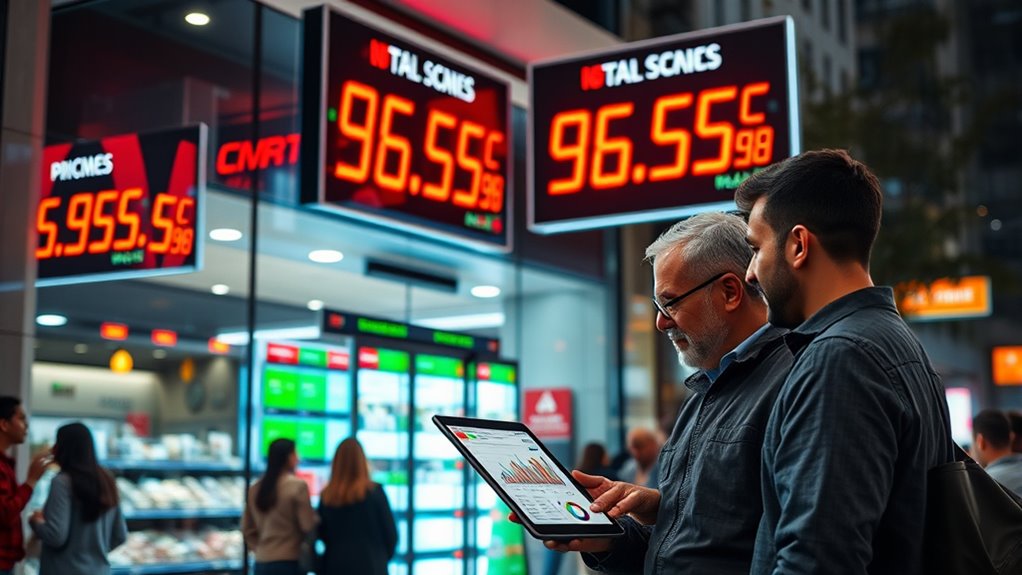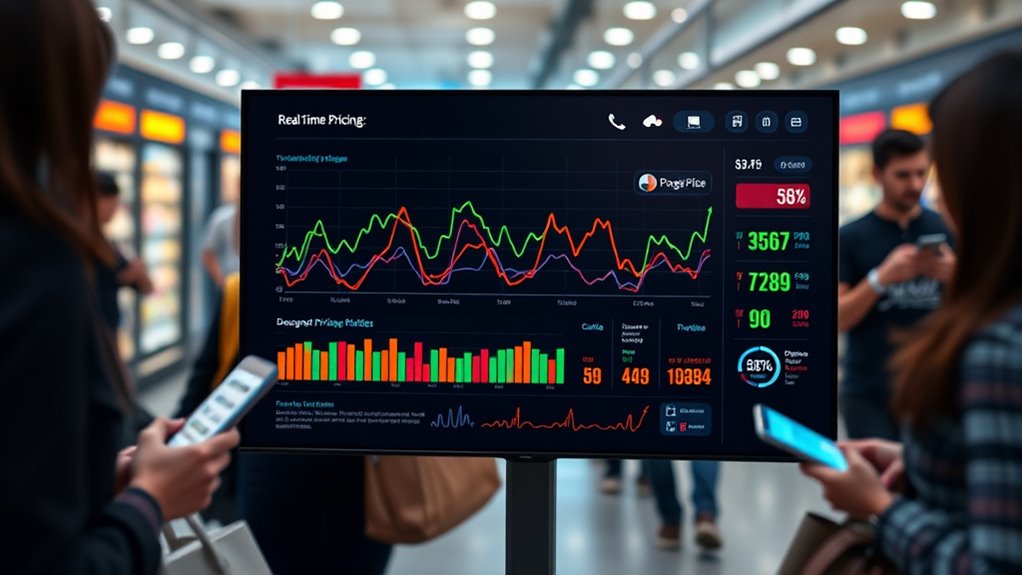Dynamic pricing is a strategy where prices change in real time based on market demand, competition, and other factors. It uses algorithms and technology to adjust prices quickly, helping businesses maximize revenue and stay competitive. This approach is common in airlines, hotels, and online retail. As markets and customer behavior shift, so do prices—if you want to learn how this impacts you and businesses, keep exploring.
Key Takeaways
- Dynamic pricing is a strategy where prices fluctuate based on market demand, competition, and other real-time factors.
- It utilizes algorithms and data analysis to adjust prices frequently rather than keeping them fixed.
- Common in industries like airlines, hotels, and retail, aiming to maximize revenue and competitiveness.
- Real-time market data, including consumer behavior and competitor prices, inform instant price adjustments.
- Advanced technology enables personalized, responsive pricing to meet market conditions and customer needs.
The Definition of Dynamic Pricing

What exactly is dynamic pricing? It’s a strategy where prices change frequently based on market demand, competition, and other factors. Instead of setting a fixed price, businesses adjust their rates to maximize revenue and stay competitive. Think of it as a flexible pricing system that responds to real-time data. For example, airline tickets and hotel rooms often have prices that fluctuate depending on how many seats or rooms are left and how close the date is. This approach allows companies to optimize profits and better meet customer expectations. Dynamic pricing relies on algorithms and automation to make quick decisions, ensuring prices stay relevant and competitive at all times. It’s a smart way for businesses to adapt to changing market conditions instantly. Additionally, understanding consumer behavior and emotional responses can be crucial for implementing effective pricing strategies.
How Dynamic Pricing Works

You can see how dynamic pricing adjusts prices through sophisticated algorithms that analyze data constantly. These systems respond to real-time market changes, ensuring prices stay competitive. Consumer behavior also influences pricing decisions, making the process responsive and personalized. Additionally, organic and natural juices are often priced dynamically in health-conscious markets to reflect seasonal availability and ingredient freshness.
Pricing Algorithms and Data
Behind every successful dynamic pricing strategy are sophisticated algorithms that analyze vast amounts of data to determine ideal prices in real time. These algorithms process various data sources, including customer behavior, competitor prices, demand patterns, and market conditions. They identify trends and patterns, adjusting prices instantly to maximize sales and profits. You might not see the complexity behind the scenes, but it’s these calculations that set prices dynamically. Data inputs are continuously fed into the system, enabling the algorithms to react swiftly to changes in supply and demand. This constant data flow allows for highly responsive pricing that can optimize revenue. Additionally, well-being tips such as stress management strategies can help stakeholders maintain clarity and decision-making effectiveness in fast-paced environments. By leveraging advanced analytics and machine learning, these algorithms refine their strategies over time, improving accuracy and effectiveness in competitive markets.
Real-Time Market Adjustments
Real-time market adjustments are the heart of dynamic pricing, enabling businesses to respond instantly to changing conditions. When demand spikes or supply drops, your pricing system detects these shifts immediately. For example, if a flight experiences suddenly high bookings, prices can increase to maximize revenue. Conversely, if demand falls unexpectedly, prices can decrease to attract more customers. This responsiveness relies on live data feeds, such as competitor pricing, weather, or local events. By continuously monitoring these factors, your pricing model adjusts prices on the fly, ensuring competitiveness and profitability. Additionally, understanding the growing and harvesting of chia seeds helps illustrate how adaptable strategies can optimize yields and efficiency. This agility helps you capitalize on opportunities and mitigate risks without delay. Ultimately, real-time adjustments keep your prices aligned with current market conditions, giving you a strategic edge in an ever-changing landscape.
Consumer Behavior Impact
Consumer behavior plays a crucial role in how dynamic pricing strategies are implemented and adjusted. Your purchasing patterns, search history, and browsing habits give businesses valuable insights into what you value and how much you’re willing to pay. When you frequent certain products or respond to discounts, companies use this data to set personalized prices that influence your buying decisions. If you tend to buy during sales or at specific times, businesses may adjust prices to encourage quicker purchases or maximize profits. Your responsiveness to price changes helps shape pricing models, making them more targeted and effective. Additionally, companies monitor Hyundai Tuning options and modifications to better understand consumer preferences for performance upgrades, which can influence tailored offers. Ultimately, your actions directly impact how companies set and modify prices, creating a cycle where your behavior and pricing strategies continuously influence each other.
Historical Development of Dynamic Pricing

Have you ever wondered how dynamic pricing evolved into a strategic tool used today? Its roots trace back to simple pricing tactics used in ancient markets, where sellers adjusted prices based on supply and demand. Over time, technology enabled businesses to refine this approach, especially during the 20th century, with the rise of airline and hotel industries. These industries pioneered real-time price adjustments, using data to optimize profits during fluctuating demand. Imagine:
- Early ticket prices changing depending on the season or time of day
- Retailers experimenting with discount strategies to clear stock
- Airlines using computerized systems to adjust fares quickly and efficiently
Today, advanced algorithms and big data power dynamic pricing, transforming it into a sophisticated, strategic practice that maximizes revenue and improves competitiveness. Incorporating Design Thinking principles, businesses now focus on understanding customer needs and creating innovative solutions for pricing strategies.
Types of Dynamic Pricing Strategies

Dynamic pricing strategies vary based on how businesses set and adjust prices to respond to market conditions, customer behavior, and competitive actions. You might use different approaches depending on your goals, like maximizing revenue or gaining market share. Common strategies include cost-based, where prices reflect expenses; demand-based, adjusting for customer willingness to pay; and competitor-based, responding to rivals’ prices. Here’s a quick overview:
| Strategy | Focus | Example |
|---|---|---|
| Cost-Based | Cover costs and profit margin | Markup on production costs |
| Demand-Based | Customer willingness to pay | Surge pricing during peak |
| Competitor-Based | Match or beat competitors’ prices | Price matching |
| Time-Based | Prices change over time | Early bird discounts |
| Value-Based | Customer perceived value | Premium pricing for luxury |
These strategies help tailor your pricing to market dynamics effectively. Additionally, understanding how to implement these strategies can aid in creating a more effective pricing model that aligns with your business goals.
Technologies Behind Dynamic Pricing

Advancements in technology have revolutionized how businesses implement dynamic pricing by providing real-time data analysis and automation tools. These technologies allow you to adjust prices instantly based on market demand, competitor actions, and customer behavior. With sophisticated algorithms, businesses can process vast amounts of information quickly, ensuring ideal pricing strategies. Imagine dashboards displaying live sales data, predictive analytics forecasting future trends, and AI-driven systems automatically tweaking prices. This seamless integration helps you stay competitive and maximize revenue. Visualize a system that:
- Continuously monitors competitors’ prices across platforms
- Uses machine learning to predict customer willingness to pay
- Automates price adjustments without manual input
Additionally, insights from Honda Tuning can inspire innovative approaches to optimizing your pricing models and strategies. These cutting-edge tools empower you to implement dynamic pricing efficiently, making your pricing strategy responsive, data-driven, and highly effective.
Benefits for Businesses

Are you aware of how implementing dynamic pricing can directly boost your business’s profitability? It allows you to adjust prices in real-time based on demand, competition, and market trends. This flexibility helps you maximize revenue during peak times and stay competitive when demand drops. Additionally, dynamic pricing enables better inventory management by reducing overstock and understock situations. You can also tailor prices for different customer segments, increasing conversions. Here’s a quick overview of the benefits:
| Benefit | Description | Impact |
|---|---|---|
| Increased Revenue | Prices adapt to market conditions | Higher profit margins |
| Competitive Edge | Respond quickly to competitors’ moves | Better market position |
| Inventory Optimization | Adjust prices to manage stock levels | Reduced waste and losses |
| Customer Segmentation | Personalized pricing strategies | Improved customer loyalty |
| Market Responsiveness | Real-time data use to inform pricing | Faster decision-making |
Implementing pricing strategies effectively relies on accurate data collection and analysis to stay aligned with market trends.
Impact on Consumers

Dynamic pricing can cause your costs to fluctuate unexpectedly, giving you more choices but also more uncertainty. It may influence how fair you feel the prices are and how much you trust the sellers. These changes can also shape your spending habits and how you decide when and what to buy. Being aware of seasonal variations can help you better anticipate price changes during different times of the year.
Price Fluctuations and Choices
How do price fluctuations influence your purchasing decisions? When prices change unexpectedly, you might delay buying, hunt for better deals, or switch products altogether. Fluctuating prices create a sense of uncertainty that can lead to hesitation or impulsive decisions. You may find yourself constantly monitoring prices, waiting for a sale, or feeling frustrated by sudden jumps. Visualize the following:
- Seeing a discount banner pop up just as you’re about to buy
- Watching prices climb higher right before your eyes
- Comparing multiple options, trying to find the lowest price possible
These fluctuations shape how and when you choose to spend your money. They can make you more cautious, more opportunistic, or even more skeptical of pricing strategies. Your choices become a direct response to the ever-changing market.
Perceived Fairness and Trust
When consumers perceive that pricing is fair and transparent, trust in the seller increases, making you more likely to complete a purchase. If you understand why prices fluctuate and see that adjustments are justified, you’re less suspicious and more confident in your decision. Clear communication about how prices change and the reasons behind those shifts helps you feel respected and valued. When sellers are upfront about dynamic pricing, it reduces feelings of being manipulated or taken advantage of. This transparency fosters a sense of fairness, encouraging loyalty and repeat business. Conversely, hidden or confusing pricing practices can erode trust, leading you to seek alternatives. Ultimately, perceived fairness and transparency are vital for building strong, trusting relationships between you and sellers using dynamic pricing.
Spending Habits and Behavior
Have fluctuating prices influenced your spending habits? You might find yourself delaying purchases, waiting for discounts, or buying only when prices drop. Dynamic pricing can lead you to compare prices more carefully, making you more cautious. It also encourages impulsive decisions when prices suddenly drop, pushing you to buy immediately. You could notice yourself:
- Hesitating before committing to a purchase, fearing higher prices later
- Jumping on limited-time deals to save money
- Prioritizing products that have fluctuating prices, shaping your shopping patterns
These behaviors show how dynamic pricing impacts your perception of value and urgency. You become more aware of price changes, which influences when and what you buy. Overall, your spending habits shift based on price fluctuations, affecting your financial choices daily.
Ethical Considerations and Challenges

While dynamic pricing can boost revenue and market responsiveness, it also raises significant ethical concerns that businesses must address. You might worry about fairness—customers could feel exploited if prices fluctuate unpredictably or based on their browsing history. Price discrimination can lead to perceptions of inequality, especially if certain groups consistently pay more. Transparency is another challenge; if customers don’t understand how prices are set, trust erodes. Additionally, dynamic pricing can be manipulated during high-demand periods, making it seem like price gouging. You must strike a balance between maximizing profits and maintaining honesty. Addressing these ethical issues requires clear communication, fair pricing policies, and ensuring that your pricing practices don’t unfairly disadvantage specific customer segments.
Future Trends in Dynamic Pricing

Advancements in technology and data analytics are shaping the future of dynamic pricing, making it more sophisticated and responsive than ever before. You’ll see algorithms that adapt in real-time, analyzing customer behavior, market trends, and competitor actions instantly. This means prices will become more personalized and precise, maximizing revenue and customer satisfaction. Imagine platforms that predict demand fluctuations before they happen, adjusting prices proactively. You might also encounter AI-driven systems that optimize pricing across multiple channels simultaneously, ensuring consistency and competitiveness. These innovations will create a marketplace where prices evolve dynamically, giving you better deals or higher value based on your preferences and actions. As these trends develop, expect a more seamless, data-driven shopping experience that benefits both businesses and consumers.
Frequently Asked Questions
How Do Consumers Typically React to Dynamic Pricing?
You might feel frustrated or surprised when you see prices change unexpectedly. Sometimes, you could appreciate the savings during off-peak times, but other times, you might think it’s unfair or manipulative. Your reactions vary—some may compare prices or wait for discounts, while others accept it as part of modern shopping. Overall, dynamic pricing influences your buying decisions, prompting you to stay alert and adaptable to fluctuating costs.
What Industries Rely Most Heavily on Dynamic Pricing?
You’ll find that industries like airlines, hotels, and ride-sharing services rely most heavily on dynamic pricing. They adjust prices frequently based on demand, seasonality, and market conditions. Retailers, event ticket sellers, and even energy providers also use this strategy to maximize profits and stay competitive. By constantly updating prices, these industries can better match supply with consumer demand, ensuring they stay ahead in a competitive marketplace.
Are There Legal Restrictions on Dynamic Pricing Practices?
Did you know that 85% of retailers use dynamic pricing? Laws vary by country and industry, so you need to stay compliant. You might face restrictions on price discrimination or unfair practices, especially during crises. Always research local regulations before adjusting prices. Ignoring legal limits can lead to fines or lawsuits, so it’s essential you understand the rules governing your pricing strategies to avoid legal trouble.
How Can Consumers Identify Dynamic Pricing in Real-Time?
You can spot dynamic pricing in real-time by paying close attention to price changes on websites or apps. Look for fluctuations in costs when you refresh or revisit a product or service, especially during different times of day or days of the week. Use price tracking tools or browser extensions that monitor and alert you to changes. Being aware of these patterns helps you make smarter purchasing decisions and avoid paying more than necessary.
What Are Common Misconceptions About Dynamic Pricing?
Many people think dynamic pricing always means unfair price hikes, but that’s not true. It’s often misunderstood as just price gouging, when in reality, it’s about adjusting prices based on demand, competition, or time. You might assume it’s unpredictable or manipulative, but many companies use it to offer better deals during slow periods. Recognizing these misconceptions helps you see dynamic pricing as a strategic tool rather than a scam.
Conclusion
Imagine walking into a store and finding the perfect item, only to see the price change just as you reach for it. That’s dynamic pricing in action—adapting prices like a chameleon to meet market needs. As you navigate this ever-changing landscape, remember it’s a powerful tool that can benefit both businesses and consumers when used ethically. Embrace the future, but stay mindful of the balance between innovation and fairness.









